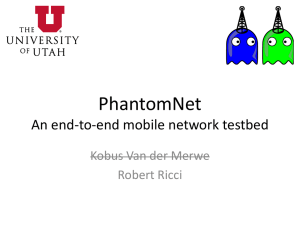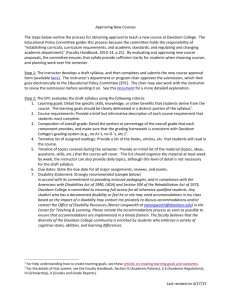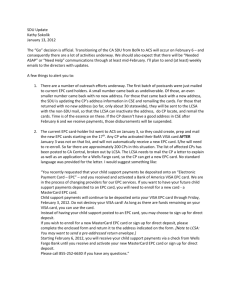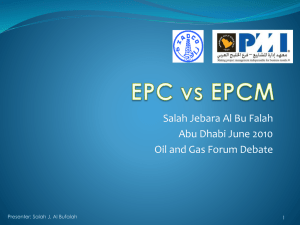Control of FWM Phase*matching Condition Using the
advertisement
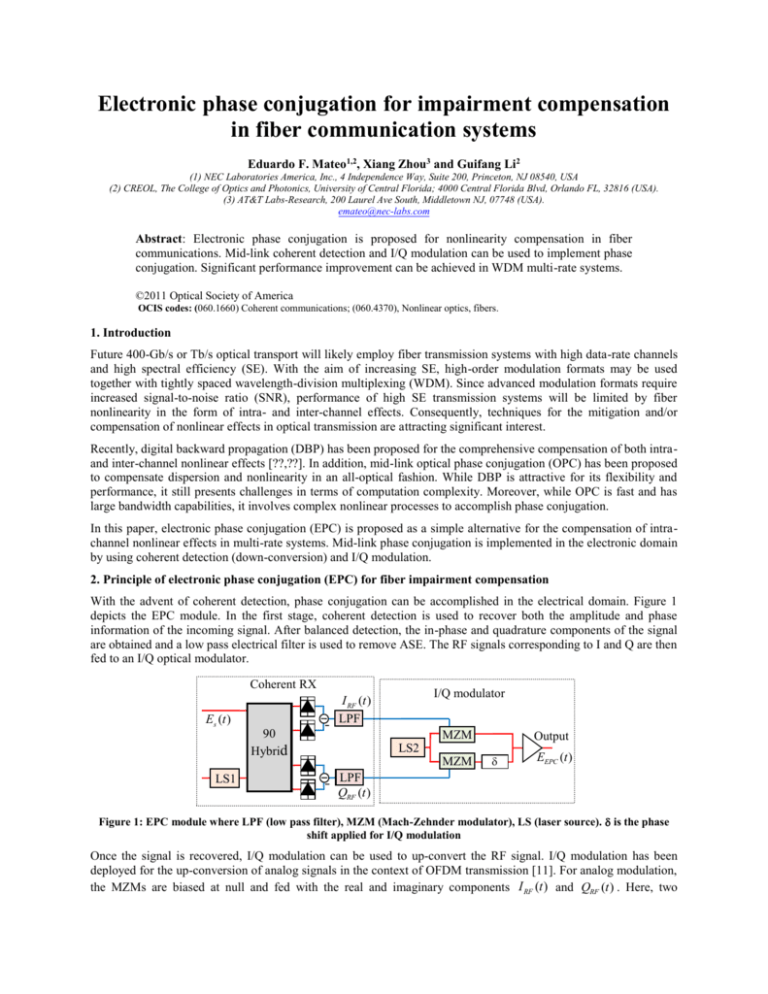
Electronic phase conjugation for impairment compensation in fiber communication systems Eduardo F. Mateo1,2, Xiang Zhou3 and Guifang Li2 (1) NEC Laboratories America, Inc., 4 Independence Way, Suite 200, Princeton, NJ 08540, USA (2) CREOL, The College of Optics and Photonics, University of Central Florida; 4000 Central Florida Blvd, Orlando FL, 32816 (USA). (3) AT&T Labs-Research, 200 Laurel Ave South, Middletown NJ, 07748 (USA). emateo@nec-labs.com Abstract: Electronic phase conjugation is proposed for nonlinearity compensation in fiber communications. Mid-link coherent detection and I/Q modulation can be used to implement phase conjugation. Significant performance improvement can be achieved in WDM multi-rate systems. ©2011 Optical Society of America OCIS codes: (060.1660) Coherent communications; (060.4370), Nonlinear optics, fibers. 1. Introduction Future 400-Gb/s or Tb/s optical transport will likely employ fiber transmission systems with high data-rate channels and high spectral efficiency (SE). With the aim of increasing SE, high-order modulation formats may be used together with tightly spaced wavelength-division multiplexing (WDM). Since advanced modulation formats require increased signal-to-noise ratio (SNR), performance of high SE transmission systems will be limited by fiber nonlinearity in the form of intra- and inter-channel effects. Consequently, techniques for the mitigation and/or compensation of nonlinear effects in optical transmission are attracting significant interest. Recently, digital backward propagation (DBP) has been proposed for the comprehensive compensation of both intraand inter-channel nonlinear effects [??,??]. In addition, mid-link optical phase conjugation (OPC) has been proposed to compensate dispersion and nonlinearity in an all-optical fashion. While DBP is attractive for its flexibility and performance, it still presents challenges in terms of computation complexity. Moreover, while OPC is fast and has large bandwidth capabilities, it involves complex nonlinear processes to accomplish phase conjugation. In this paper, electronic phase conjugation (EPC) is proposed as a simple alternative for the compensation of intrachannel nonlinear effects in multi-rate systems. Mid-link phase conjugation is implemented in the electronic domain by using coherent detection (down-conversion) and I/Q modulation. 2. Principle of electronic phase conjugation (EPC) for fiber impairment compensation With the advent of coherent detection, phase conjugation can be accomplished in the electrical domain. Figure 1 depicts the EPC module. In the first stage, coherent detection is used to recover both the amplitude and phase information of the incoming signal. After balanced detection, the in-phase and quadrature components of the signal are obtained and a low pass electrical filter is used to remove ASE. The RF signals corresponding to I and Q are then fed to an I/Q optical modulator. Coherent RX Es (t ) Input 90 Hybrid LS1 I/Q modulator I RF (t ) LPF MZM LS2 MZM Output EEPC (t ) LPF QRF (t ) Figure 1: EPC module where LPF (low pass filter), MZM (Mach-Zehnder modulator), LS (laser source). is the phase shift applied for I/Q modulation Once the signal is recovered, I/Q modulation can be used to up-convert the RF signal. I/Q modulation has been deployed for the up-conversion of analog signals in the context of OFDM transmission [11]. For analog modulation, the MZMs are biased at null and fed with the real and imaginary components I RF (t ) and QRF (t ) . Here, two equivalent options are possible for creating the phase conjugated signal. If the balanced detectors for the Q component are reversed, QRF (t ) is fed to the MZM and a phase shift of / 2 has to be applied to the I/Q modulator. Alternatively, if QRF (t ) is fed to the MZM / 2 has to be applied. 3. EPC in Raman-amplified multi-rate system A multi-rate system comprised of a high-speed express channel (64-QAM-OFDM, 600 Gb/s, 100 GBaud) and WDM neighboring channels (single carrier, QPSK 50 Gb/s, 25 GBaud) has been simulated. Despite polarization transmission is considered for simplicity, the EPC formulation can be extended to polarization-division multiplexing by using a polarization-diverse receiver in the EPC module. A multi-band OFDM signal of 100 Gbaud is considered as the express channel. Multi-band OFDM channels (also called super-channels) have been proposed recently as candidates for high spectral efficiency transmission [??,??]. To overcome bandwidth limitations of ADC/DACs, multi-band techniques have been used to create the OFDM super-channel. In our case, the EPC module does not require ADC/DAC but it is still limited by the bandwidth of the photo-detectors and/or RF amplifiers. To overcome this limitation, the OFDM super-channel can be split into sub-bands by using a set of phase-locked local oscillators. After coherent detection, each sub-band can be up-converted and finally combined using a multiplexer. Note that phase conjugation leads to spectral inversion. Therefore, the up-conversion of the sub-band has to be wavelengthinverted. Fig. 2 shows a schematic of the simulated system. 100G-QPSK Span 1 ROADM Span M/2 add drop 100G-QPSK EPC 50G-QPSK RX MUX 100 km SSMF DEMUX 600G-OFDM 600G-OFDM (Express channel) Span M Span M/2+1 ROADM MUX TX DEMUX 100G-QPSK Pump 2 Pump 1 DROP ADD Signal Pump 1 Pump 2 Figure 2: Multi-rate transmission system with add/drop multiplexing and mid-span EPC. The 64-QAM-OFDM express channel is transmitted together with 6 neighboring QPSK channels. The channel spacing between the QPSK channels is 50 GHz whereas the spacing between the express channel and the next QPSK channel is 100 GHz. This channel spacing is chosen as a trade-off between spectral efficiency and EPC performance. Since the express channel carries high power, spectral broadening is expected and the newly generated frequency components have to be also phase-conjugated to achieve optimum performance. Therefore, a guard band is placed between the high-SNR express channel and the neighboring channels. After each span, QPSK channels can be added or dropped. The express channel is not dropped and EPC is performed in the mid-link. The OFDM express channel comprises 128 subcarriers modulated with a 64-QAM format. A sequence of 32768 symbols (196608 bits) has been simulated for the express OFDM channel. Regarding the QPSK channels, 8182 symbols per channel are transmitted. To recreate a more realistic link, the QPSK channels are pre-propagated (without the express channel) through a link with EDFA amplification and 14 spans of 100 km SSMF. Then, the QPSK channels are added/dropped before/after each fiber span. To assess the significance of interchannel effects, two different power values are considered for the QPSK channels. The link consists of M 10 spans of 100 km of standard single mode fiber (SSMF) and Raman amplification. The fiber has a dispersion parameter of D 16 ps/km/nm and a dispersion slope of Ds 0.08 ps/km/nm 2 . The loss is 0.2 dB/km and the nonlinear coefficient is 1.46 1/W/km . Since EPC requires power symmetry with respect to the EPC location [??,??], distributed Raman amplification will be used. To further improve symmetry, cascaded Raman amplification can be used. The Raman pumps are chosen to fully compensate the 20 dB loss per span. In typical WDM systems, where all the channels have same power and carry the same bit-rate, the compensation of intra-channel effects has been proven inefficient due to the effect of inter-channel nonlinearities [??]. In this work, a multi-rate system is explored with a high-speed express channel and neighboring low rate channels. In this scenario, SNR requirements for the low rate channels are not high and inter-channel effects may be sufficiently small to enable the compensation of intra-channel nonlinearities of the express channel. 4. Results and discussion Q (dB) [Express channel] Figure 3 shows the performance results for the OFDM express channel in presence of neighboring QPSK channels. Together, the constellation diagram of the QPSK channels for the different power regimes is shown. PQPSK 9 dBm 27 PQPSK 3 dBm 26 PQPSK 3 dBm 25 QQPSK 14.18 dBm 24 EPC on 23 22 21 PQPSK 9 dBm 20 19 18 -2 -1 0 1 2 EPC off 3 QQPSK 10.8 dBm 4 5 Power (dBm) Figure 3: Performance of 600 Gb/s OFDM express channel in WDM transmission Plots are shown for different power values of the QPSK channels. Fig. 3 shows that EPC substantially increases both optimum power and Q-factor. In fact a 4.1 dB improvement is obtained in the Q-factor, enabled by an increase of around 4 dB in the optimum launching power. As the power of the QPSK channels is increased, cross-phase modulation gains strength and EPC looses efficiency. However, due to the large contribution of SPM, EPC still provides a significant improvement of 4.3 dB. In fact, a higher improvement is obtained for PQPSK 3 dBm which suggests that the combined effects of XPM and SPM can be also compensated by EPC. Alternatively a 3dB increase in the Q-factor for the higher power QPSK channels. Clearly, a performance trade-off is found between QPSK neighboring channels and OFDM express channel. Here, the channel spacing between the express channel and the next QPSK channels is crucial to preserve the efficiency of EPC. For a channel spacing of 100 GHz, results confirm that EPC efficiently compensates intra-channel effects for a wide range of neighboring-channel power values. Even though such guard band penalizes spectral efficiency, the compensation of nonlinearity provided by EPC provides allows the transmission of highly spectral efficient modulation format which significantly increase the overall spectral efficiency. 5. Conclusion A new scheme for nonlinearity compensation is presented. Mid-link electronic phase conjugation (EPC) is proposed as an alternative to optical phase conjugation or digital backward propagation. EPC is simple to implement and provides significant improvement due to compensation of nonlinear effects. More than 4 dB of improvement can be achieved when EPC is used. References [1] W. Shieh, et al., Opt. Express, 16, 841 (2008). [2] R. Drishler, et al., OFC 2009, PDPC2. [3] B. Goebel, et al., OFC 2008, JWA58. [4] X. Li et al., Opt. Express, 16, 880 (2008). [5] G. Goldfarb, et al., Photon. Technol. Lett. 20, 1887 (2008). [6] F. Yaman, et al., Photonics Journal, IEEE, 1,144 (2009). [7] E. Mateo et al., Opt. Express, 16, 16124 (2008). [8] E. Mateo et al., Appl. Opt. 48, F6 (2009). [9] G. P. Agrawal, “Nonlinear fiber optics”, (Academic Press, 2005). [10] D. Marcuse et al., J. Lightwave Technol., 15, 1735 (1997).
